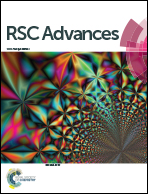Introducing Ti3+ defects based on lattice distortion for enhanced visible light photoreactivity in TiO2 microspheres†
Abstract
Defective titanium dioxide (TiO2) is of much significance due to its improved visible light photoreactivity. Generally, the existence of defects leads to imperfections in the crystal lattice, which in turn affect the dynamics of the evolution of defects and the corresponding physical properties of TiO2. Until now, how lattice distortion affects the formation of Ti3+ defects as well as the corresponding visible light photoreactivity in TiO2 has remained elusive. Herein, we have successfully introduced Ti3+ defects based on lattice distortion in TiO2 microspheres and found the photocurrent of anatase TiO2 has been significantly enhanced from 1.78 to 80 μA cm−2 with an increase in photocatalytic activity of almost three times under visible light irradiation. Furthermore, we show that lattice distortions have minimal contribution to enhancing the visible light photocatalytic activity because the band gap cannot be narrowed due to the absence of Ti3+ defects, yet the existence of lattice distortions could suppress the recombination of electron–hole pairs. Moreover, the formation of Ti3+ defects is energetically favored in lattice-distorted TiO2 compared to that of pristine TiO2. This work highlights the design and development of highly efficient TiO2 photocatalysts that operate under visible light irradiation.



 Please wait while we load your content...
Please wait while we load your content...